Hydrological Response of the Irrawaddy River Under Climate Change Based on CV-LSTM Model
Abstract
1. Introduction
2. Materials and Methods
2.1. Study Area
2.2. Data Collection
2.3. Methods
2.3.1. The CV-LSTM Model
2.3.2. Model Performance Evaluation
2.3.3. Climate Change Scenario Development Methods
- (1)
- Continuous variable calibration method:where represents the calibrated future scenario data for the continuous variable; is the mean value of the historical continuous variable data; is the mean value of the GCM historical continuous variable data. denotes the GCM future scenario data for the continuous variable.
- (2)
- Discrete variable calibration method:where represents the calibrated future scenario data for the discrete variable; is the mean value of the historical discrete variable data; is the mean value of the GCM historical discrete variable data. denotes the GCM future scenario data for the discrete variable.
2.3.4. Coefficient of Variation (Cv) and the Complete Regulation Coefficient of Runoff Distribution (Cr)
3. Results and Discussion
3.1. Hydrological Model Calibration and Validation
3.2. Future Climate Change Trends in the Dulongjiang-Irrawaddy River Basin
3.2.1. Future Precipitation Change Trends
3.2.2. Future Temperature Change Trends
3.3. Hydrological Response Under the Climate Change Scenarios in the Dulongjiang-Irrawaddy River Basin
3.3.1. Interannual Runoff Variations
3.3.2. Intra-Annual Variations in Runoff
3.3.3. Extreme Runoff Changes
4. Conclusions
Author Contributions
Funding
Data Availability Statement
Conflicts of Interest
References
- Lewandowsky, S. Future Global Change and Cognition. Top. Cogn. Sci. 2016, 8, 7–18. [Google Scholar] [CrossRef] [PubMed]
- Sirisena, T.a.J.G.; Maskey, S.; Bamunawala, J.; Ranasinghe, R. Climate Change and Reservoir Impacts on 21st-Century Streamflow and Fluvial Sediment Loads in the Irrawaddy River, Myanmar. Front. Earth Sci. 2021, 9, 644527. [Google Scholar] [CrossRef]
- Kreft, S.; Eckstein, D.; Dorsch, L.; Fischer, L. Global Climate Risk Index 2016; Germanwatch e.V.: Bonn, Germany, 2016. [Google Scholar]
- Schneider, P.; Asch, F. Rice Production and Food Security in Asian Mega Deltas-A Review on Characteristics, Vulnerabilities and Agricultural Adaptation Options to Cope with Climate Change. J. Agron. Crop Sci. 2020, 206, 491–503. [Google Scholar] [CrossRef]
- Dey, P.; Mishra, A. Separating the Impacts of Climate Change and Human Activities on Streamflow: A Review of Methodologies and Critical Assumptions. J. Hydrol. 2017, 548, 278–290. [Google Scholar] [CrossRef]
- Nguyen, B.Q.; Van Binh, D.; Tran, T.-N.-D.; Kantoush, S.A.; Sumi, T. Response of Streamflow and Sediment Variability to Cascade Dam Development and Climate Change in the Sai Gon Dong Nai River Basin. Clim. Dyn. 2024, 62, 7997–8017. [Google Scholar] [CrossRef]
- Yan, J.; Jia, S.; Lv, A.; Zhu, W. Water Resources Assessment of China’s Transboundary River Basins Using a Machine Learning Approach. Water Resour. Res. 2019, 55, 632–655. [Google Scholar] [CrossRef]
- Zhang, Z.; Zhang, Q.; Singh, V.P.; Shi, P. River Flow Modelling: Comparison of Performance and Evaluation of Uncertainty Using Data-Driven Models and Conceptual Hydrological Model. Stoch. Environ. Res. Risk Assess. 2018, 32, 2667–2682. [Google Scholar] [CrossRef]
- Jiang, S.; Zheng, Y.; Babovic, V.; Tian, Y.; Han, F. A Computer Vision-Based Approach to Fusing Spatiotemporal Data for Hydrological Modeling. J. Hydrol. 2018, 567, 25–40. [Google Scholar] [CrossRef]
- Deng, C.; Yin, X.; Zou, J.; Wang, M.; Hou, Y. Assessment of the Impact of Climate Change on Streamflow of Ganjiang River Catchment via LSTM-Based Models. J. Hydrol. Reg. Stud. 2024, 52, 101716. [Google Scholar] [CrossRef]
- Madhavi, M.; Kolikipogu, R.; Prabakar, S.; Banerjee, S.; Maguluri, L.P.; Raj, G.B.; Balaram, A. Experimental Evaluation of Remote Sensing–Based Climate Change Prediction Using Enhanced Deep Learning Strategy. Remote Sens. Earth Syst. Sci. 2024, 7, 642–656. [Google Scholar] [CrossRef]
- Kedam, N.; Tiwari, D.K.; Kumar, V.; Khedher, K.M.; Salem, M.A. River Stream Flow Prediction through Advanced Machine Learning Models for Enhanced Accuracy. Results Eng. 2024, 22, 102215. [Google Scholar] [CrossRef]
- Yuan, X.; Wang, J.; He, D.; Lu, Y.; Sun, J.; Li, Y.; Guo, Z.; Zhang, K.; Li, F. Influence of Cascade Reservoir Operation in the Upper Mekong River on the General Hydrological Regime: A Combined Data-Driven Modeling Approach. J. Environ. Manag. 2022, 324, 116339. [Google Scholar] [CrossRef]
- Chen, D.; Li, X.; Saito, Y.; Liu, J.P.; Duan, Y.; Liu, S.; Zhang, L. Recent Evolution of the Irrawaddy (Ayeyarwady) Delta and the Impacts of Anthropogenic Activities: A Review and Remote Sensing Survey. Geomorphology 2020, 365, 107231. [Google Scholar] [CrossRef]
- Supharatid, S.; Nafung, J.; Aribarg, T. Projected Changes in Temperature and Precipitation over Mainland Southeast Asia by CMIP6 Models. J. Water Clim. Chang. 2022, 13, 337–356. [Google Scholar] [CrossRef]
- Iqbal, Z.; Shahid, S.; Ahmed, K.; Ismail, T.; Ziarh, G.F.; Chung, E.-S.; Wang, X. Evaluation of CMIP6 GCM Rainfall in Mainland Southeast Asia. Atmos. Res. 2021, 254, 105525. [Google Scholar] [CrossRef]
- Ojala, T.; Pietikäinen, M.; Mäenpää, T. Multiresolution Gray-Scale and Rotation Invariant Texture Classification with Local Binary Patterns. IEEE Trans. Pattern Anal. Mach. Intell. 2002, 24, 971–987. [Google Scholar] [CrossRef]
- Hochreiter, S.; Schmidhuber, J. Bridging Long Time Lags by Weight Guessing and “long Short Term Memory”. In Proceedings of the Spatiotemporal Models In Biological And Artificial Systems; Silva, F.L., Principe, J.C., Almeida, L.B., Eds.; IOS Press: Amsterdam, The Netherlands, 1997; Volume 37, pp. 65–72. [Google Scholar]
- Qiu, R.; Wang, Y.; Rhoads, B.; Wang, D.; Qiu, W.; Tao, Y.; Wu, J. River Water Temperature Forecasting Using a Deep Learning Method. J. Hydrol. 2021, 595, 126016. [Google Scholar] [CrossRef]
- Kratzert, F.; Klotz, D.; Shalev, G.; Klambauer, G.; Hochreiter, S.; Nearing, G. Towards Learning Universal, Regional, and Local Hydrological Behaviors via Machine Learning Applied to Large-Sample Datasets. Hydrol. Earth Syst. Sci. 2019, 23, 5089–5110. [Google Scholar] [CrossRef]
- Moriasi, D.N.; Arnold, J.G.; Van Liew, M.W.; Bingner, R.L.; Harmel, R.D.; Veith, T.L. Model Evaluation Guidelines for Systematic Quantification of Accuracy in Watershed Simulations. Trans. ASABE 2007, 50, 885–900. [Google Scholar] [CrossRef]
- Moss, R.H.; Edmonds, J.A.; Hibbard, K.A.; Manning, M.R.; Rose, S.K.; van Vuuren, D.P.; Carter, T.R.; Emori, S.; Kainuma, M.; Kram, T.; et al. The next Generation of Scenarios for Climate Change Research and Assessment. Nature 2010, 463, 747–756. [Google Scholar] [CrossRef] [PubMed]
- Xu, Z.; Han, Y.; Tam, C.-Y.; Yang, Z.-L.; Fu, C. Bias-Corrected CMIP6 Global Dataset for Dynamical Downscaling of the Historical and Future Climate (1979–2100). Sci. Data 2021, 8, 293. [Google Scholar] [CrossRef] [PubMed]
- Supharatid, S.; Aribarg, T.; Nafung, J. Bias-Corrected CMIP6 Climate Model Projection over Southeast Asia. Theor. Appl. Climatol. 2022, 147, 669–690. [Google Scholar] [CrossRef]
- Yang, Y.; Bai, L.; Wang, B.; Wu, J.; Fu, S. Reliability of the Global Climate Models during 1961-1999 in Arid and Semiarid Regions of China. Sci. Total Environ. 2019, 667, 271–286. [Google Scholar] [CrossRef] [PubMed]
- Hamed, M.M.; Nashwan, M.S.; Shahid, S.; bin Ismail, T.; Wang, X.; Dewan, A.; Asaduzzaman, M. Inconsistency in Historical Simulations and Future Projections of Temperature and Rainfall: A Comparison of CMIP5 and CMIP6 Models over Southeast Asia. Atmos. Res. 2022, 265, 105927. [Google Scholar] [CrossRef]
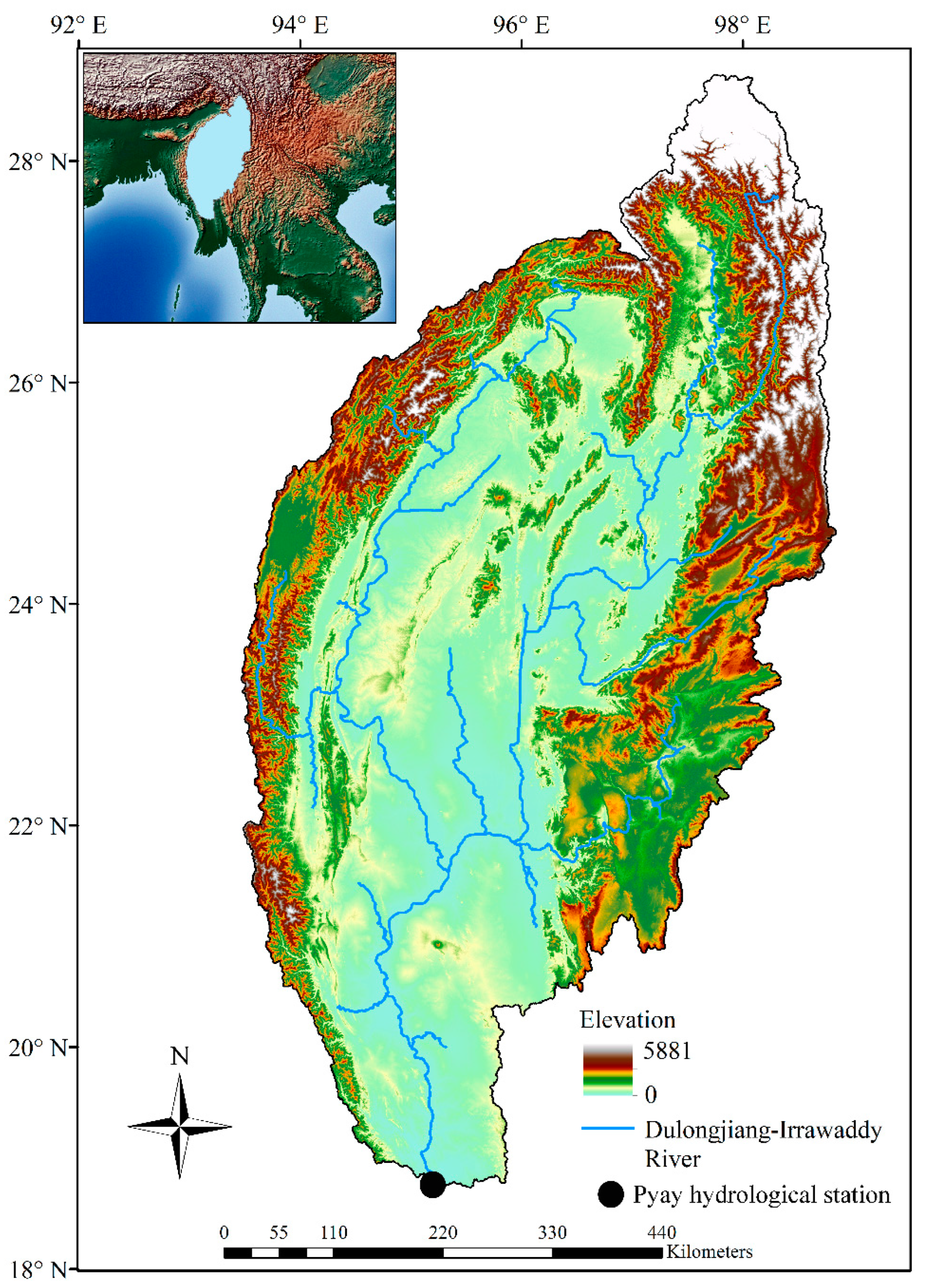
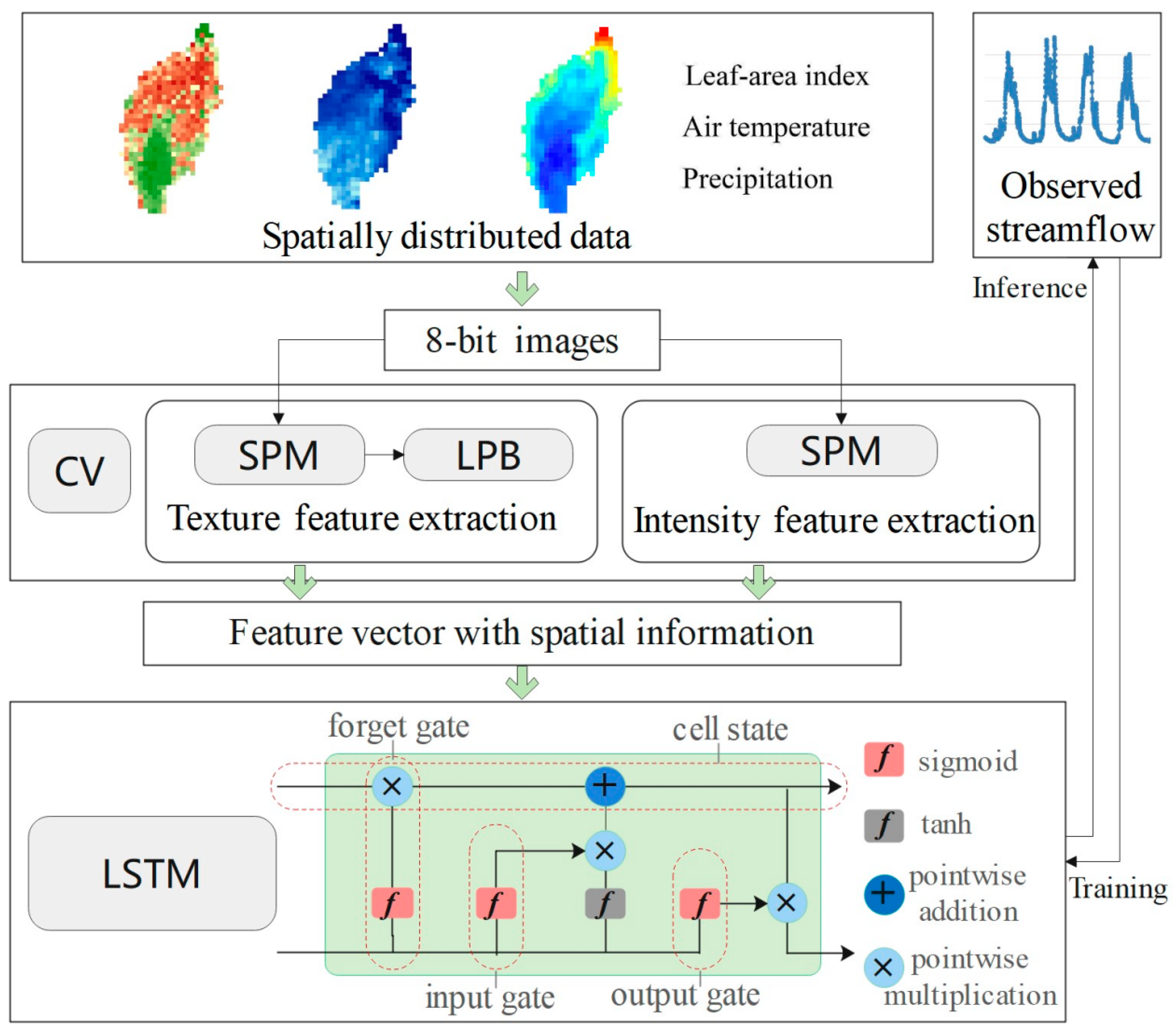

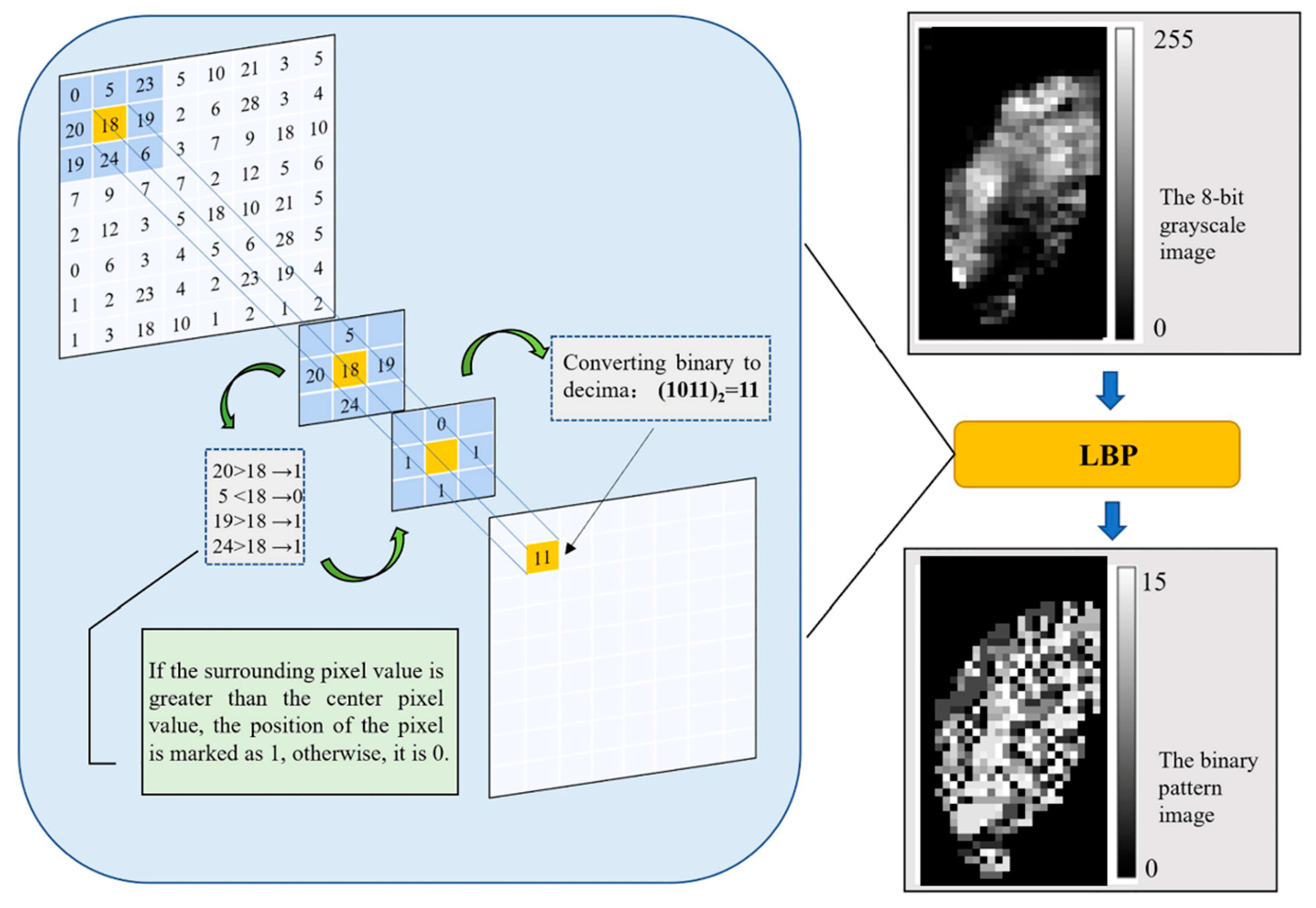


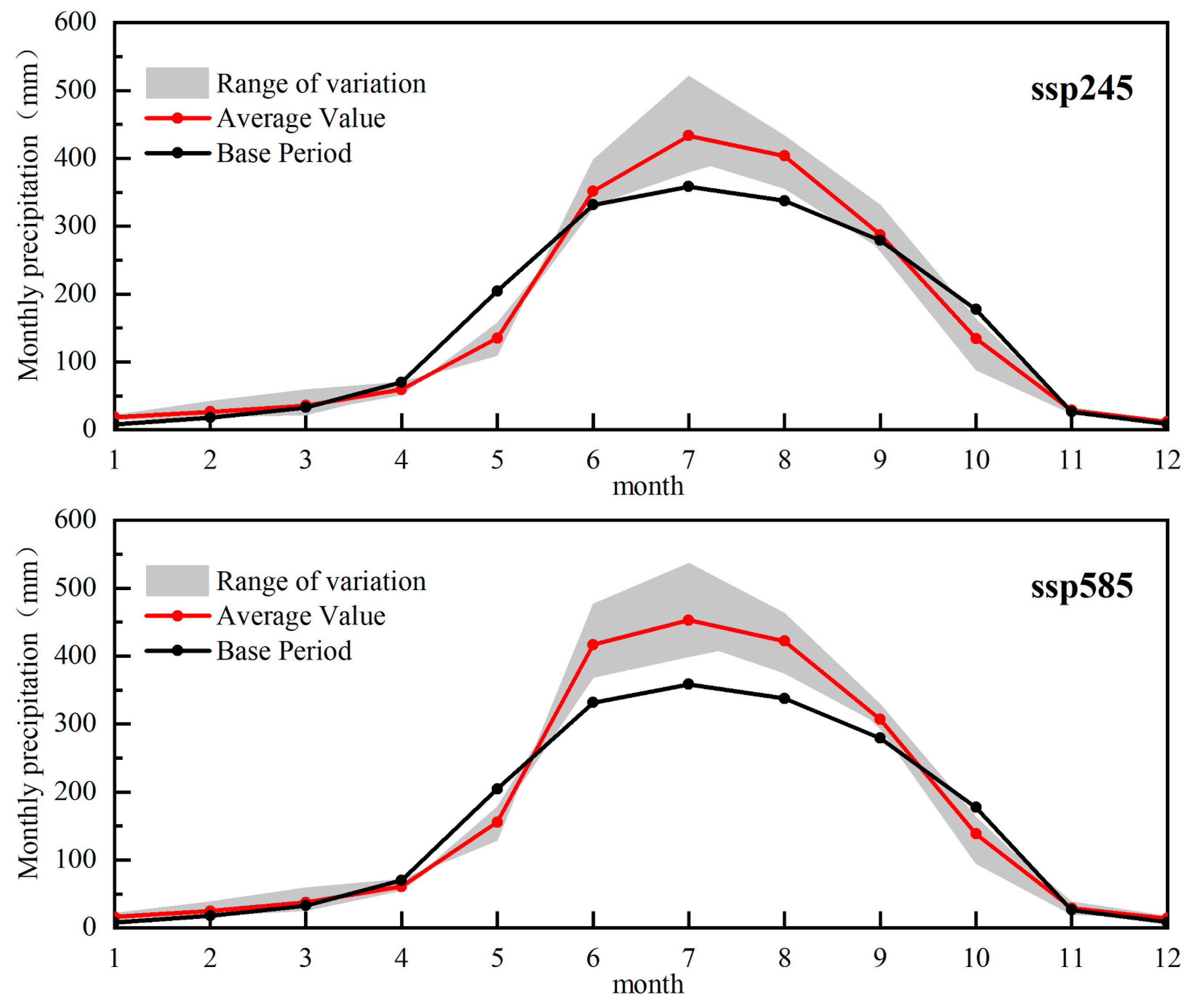



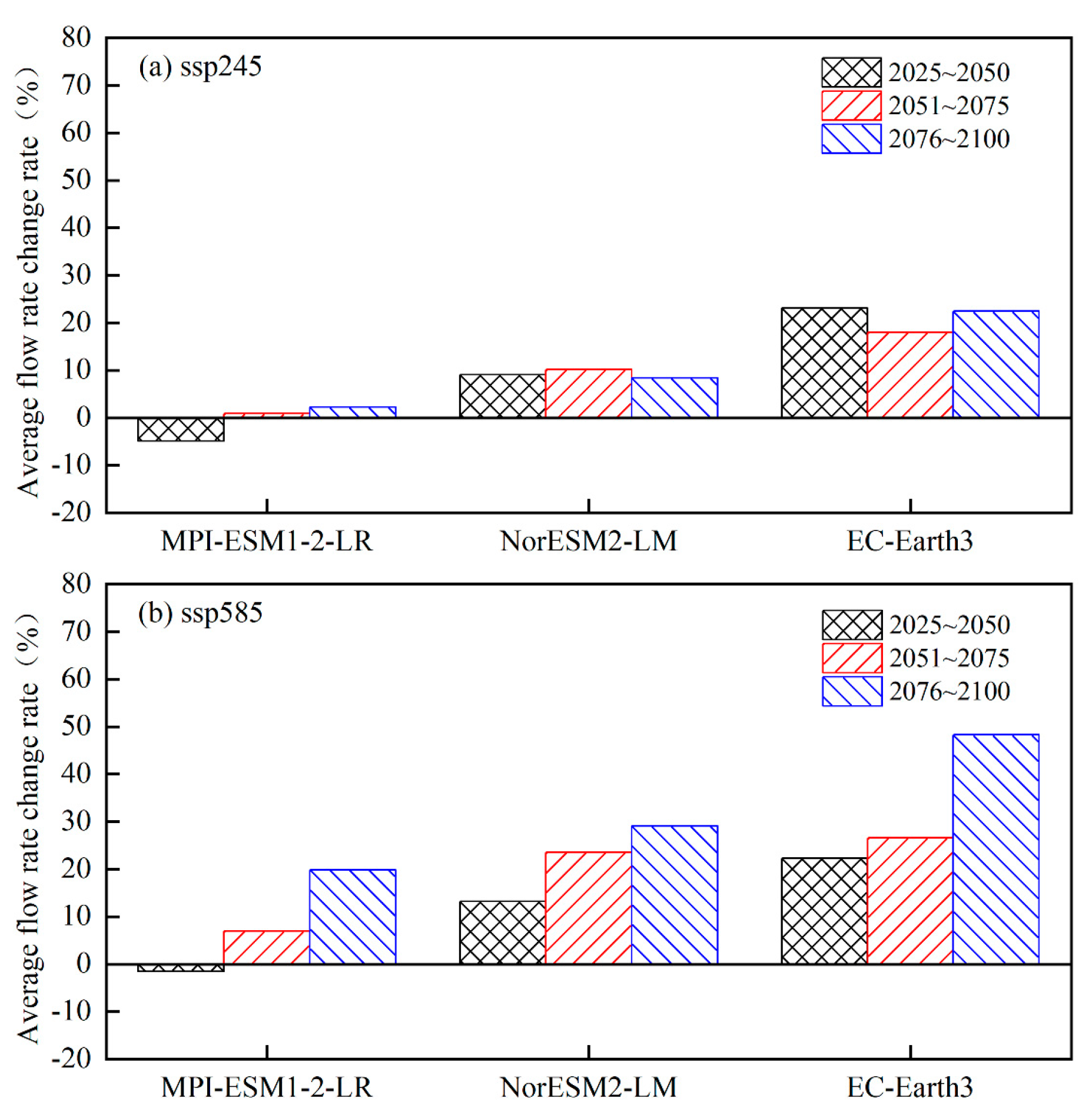

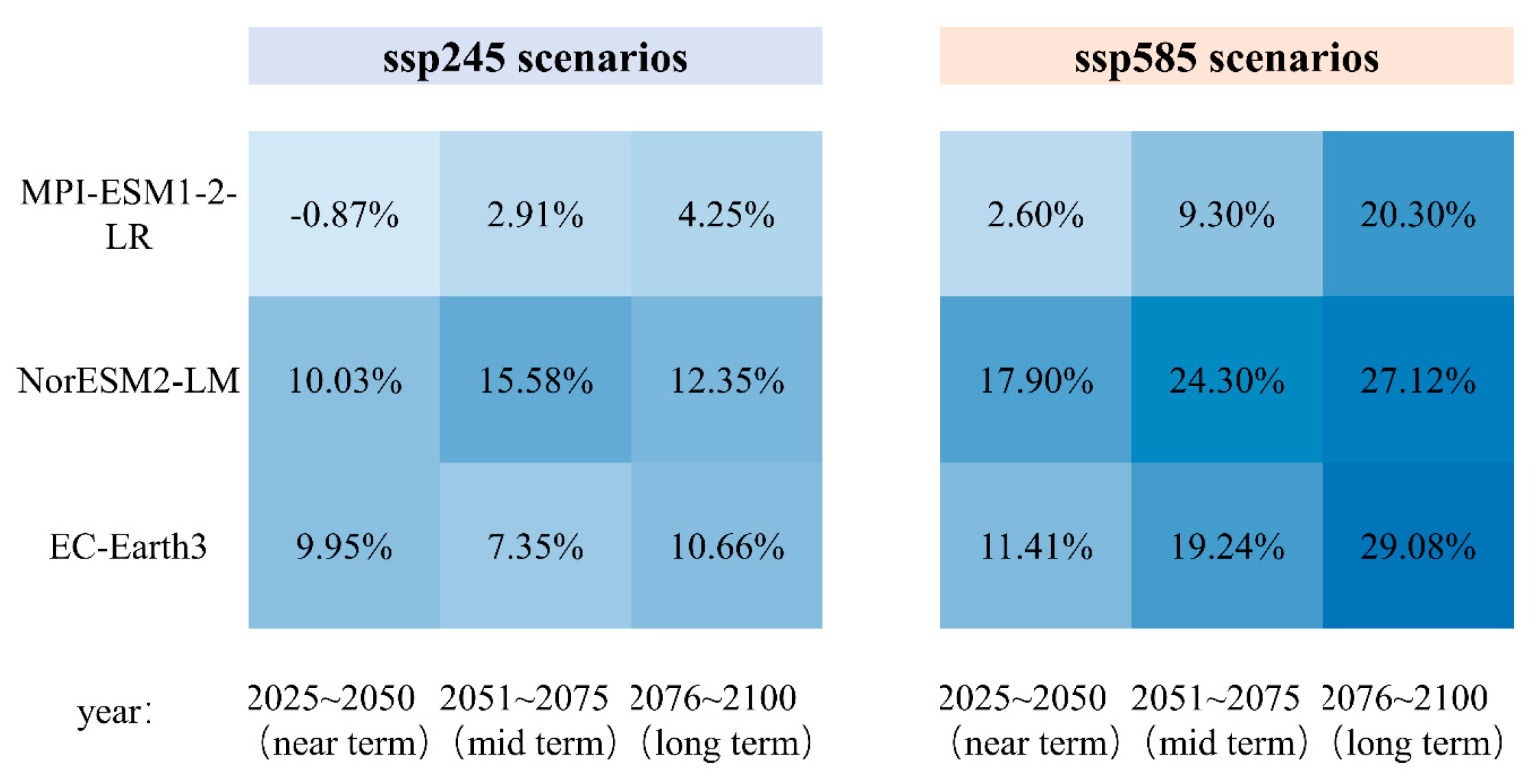
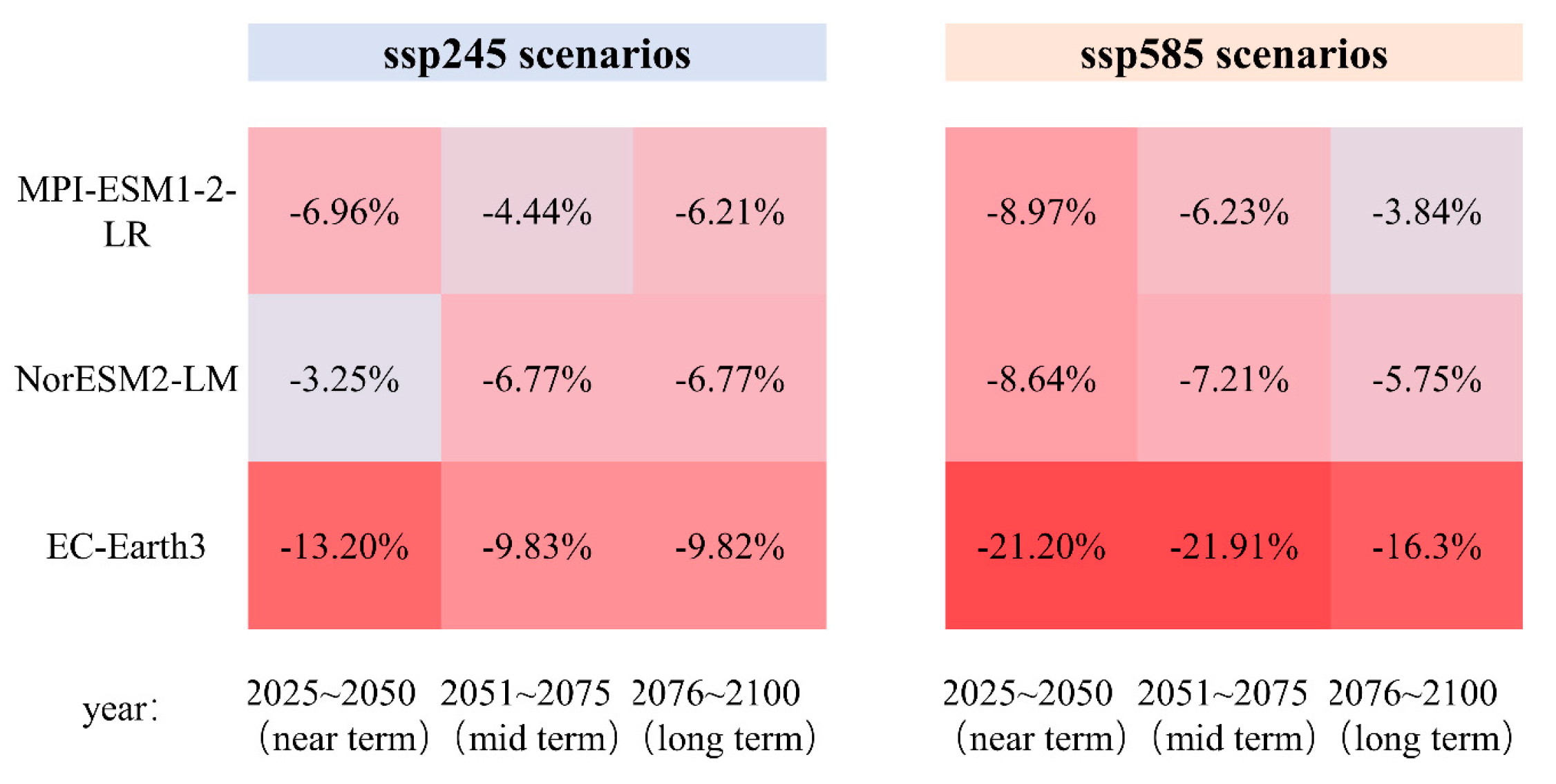
| Data Type | Data Feature | Time Step | Products | Data Source |
|---|---|---|---|---|
| Streamflow | Hydrological station | daily | Observation | https://portal.grdc.bafg.de (accessed on 7 January 2024) |
| Precipitation | 0.25° × 0.25° | daily | CHIRPS-2.0 | https://data.chc.ucsb.edu (accessed on 7 January 2024) |
| Air temperature | 0.1° × 0.1° | hourly | ERA5 | https://cds.climate.copernicus.eu (accessed on 7 January 2024) |
| Leaf area index | 0.05° × 0.05° | 8 days | GLASS | http://www.glass.umd.edu (accessed on 7 January 2024) |
| GCMs | Data Feature | Research Center |
|---|---|---|
| NorESM2-LM | 0.7031° × 0.7017° | Norwegian Meteorological Institute |
| MPI-ESM1-2-LR | 1.875° × 1.875° | Max Planck Institute for Meteorology, Germany |
| EC-Earth3 | 0.7031° × 0.7017° | EC-Earth Consortium |
| Training Period (1996–2005) | Testing Period (2006–2010) | |||||||
|---|---|---|---|---|---|---|---|---|
| r | RSR | Ens | PBIAS (%) | r | RSR | Ens | PBIAS (%) | Evaluation Grade |
| 0.99 | 0.09 | 0.99 | 0.71 | 0.95 | 0.31 | 0.90 | −3.0 | Excellent |
| Scenario | Time Period (Year) | Precipitation Change (%) |
|---|---|---|
| SSP2-4.5 | 2025–2100 | +5.5% |
| 2076–2100 | +12% | |
| SSP5-8.5 | 2025–2100 | +6.7% |
| 2076–2100 | +25.6% |
| Scenario | Time Period (Month) | Precipitation Change (%) | Precipitation Change (Absolute Value, mm/Month) |
|---|---|---|---|
| SSP2-4.5 | 5 | 34% | −69.63 mm |
| 7 | 20.9% | 74.88 mm | |
| 8 | 19.6% | 66.26 mm | |
| 10 | 24.1% | −42.70 mm | |
| SSP5-8.5 | 5 | −24% | −49.08 mm |
| 6 | 25.8% | 85.47 mm | |
| 7 | 26.4% | 94.50 mm | |
| 8 | 25% | 84.49 mm | |
| 10 | −21% | −38.91 mm |
| Scenario | Time Period (Year) | Annual Average Temperature (°C) | Temperature Change Range (°C) | The Time Point When the Temperature Reaches +2.0 °C | End-Of-Century Annual Average Temperature (°C) | End-Of-Century Temperature Increase (°C) |
|---|---|---|---|---|---|---|
| SSP2-4.5 | 2025–2100 | 22.7 | +1.57 | 2074 | 23.64 | +2.51 |
| SSP5-8.5 | 2025–2100 | 23.39 | +2.26 | 2060 | 24.95 | +3.82 |
| Scenario | Time Period (Month) | Temperature Change Range (°C) |
|---|---|---|
| SSP2-4.5 | 5 | +2.90 |
| 6 | +2.37 | |
| SSP5-8.5 | 5 | +3.84 |
| 6 | +2.96 |
| GCM Climate Models | SSP2-4.5 Different Time Periods | SSP5-8.5 Different Time Periods | ||||||
|---|---|---|---|---|---|---|---|---|
| Near-Term | Mid-Term | Long-Term | Average Period | Near-Term | Mid-Term | Long-Term | Average Period | |
| NorESM2-LM | 0.91 | 0.91 | 0.90 | 0.91 | 0.94 | 0.95 | 0.91 | 0.93 |
| MPI-ESM1-2-LR | 0.98 | 0.97 | 0.97 | 0.97 | 0.99 | 0.98 | 0.99 | 0.99 |
| EC-Earth3 | 0.91 | 0.93 | 0.94 | 0.93 | 0.96 | 0.95 | 0.96 | 0.96 |
| GCM Climate Models | SSP2-4.5 Different Time Periods | SSP5-8.5 Different Time Periods | ||||||
|---|---|---|---|---|---|---|---|---|
| Near-Term | Mid-Term | Long-Term | Average Period | Near-Term | Mid-Term | Long-Term | Average Period | |
| NorESM2-LM | 0.31 | 0.30 | 0.32 | 0.31 | 0.31 | 0.31 | 0.32 | 0.31 |
| MPI-ESM1-2-LR | 0.30 | 0.31 | 0.31 | 0.31 | 0.31 | 0.31 | 0.32 | 0.31 |
| EC-Earth3 | 0.32 | 0.32 | 0.31 | 0.32 | 0.34 | 0.33 | 0.32 | 0.33 |
Disclaimer/Publisher’s Note: The statements, opinions and data contained in all publications are solely those of the individual author(s) and contributor(s) and not of MDPI and/or the editor(s). MDPI and/or the editor(s) disclaim responsibility for any injury to people or property resulting from any ideas, methods, instructions or products referred to in the content. |
© 2025 by the authors. Licensee MDPI, Basel, Switzerland. This article is an open access article distributed under the terms and conditions of the Creative Commons Attribution (CC BY) license (https://creativecommons.org/licenses/by/4.0/).
Share and Cite
Luo, X.; Yuan, X.; Guo, Z.; Lu, Y.; Li, C.; Peng, L. Hydrological Response of the Irrawaddy River Under Climate Change Based on CV-LSTM Model. Water 2025, 17, 479. https://doi.org/10.3390/w17040479
Luo X, Yuan X, Guo Z, Lu Y, Li C, Peng L. Hydrological Response of the Irrawaddy River Under Climate Change Based on CV-LSTM Model. Water. 2025; 17(4):479. https://doi.org/10.3390/w17040479
Chicago/Turabian StyleLuo, Xiangyang, Xu Yuan, Zipu Guo, Ying Lu, Cong Li, and Li Peng. 2025. "Hydrological Response of the Irrawaddy River Under Climate Change Based on CV-LSTM Model" Water 17, no. 4: 479. https://doi.org/10.3390/w17040479
APA StyleLuo, X., Yuan, X., Guo, Z., Lu, Y., Li, C., & Peng, L. (2025). Hydrological Response of the Irrawaddy River Under Climate Change Based on CV-LSTM Model. Water, 17(4), 479. https://doi.org/10.3390/w17040479







